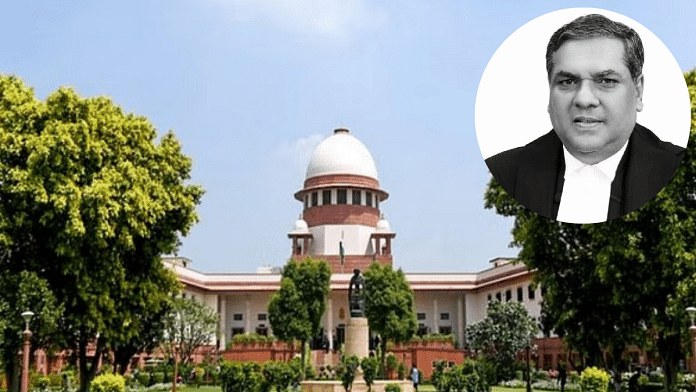New Delhi: In December 2023, the Supreme Court unanimously upheld the abrogation of Article 370 and the reorganisation of Jammu and Kashmir into two Union Territories. While giving its stamp on the government’s decision, a five-judge Constitution bench had fixed a deadline for 30 September, 2024 to carry out elections to the government.
Chief Justice of India (CJI) D.Y.Chandrachud authored the main judgment on behalf of himself, while Justices B.R. Gavai and Surya Kant wrote 352 pages. Justice S.K. Kaul wrote a separate opinion comprising 121 pages. Justice Sanjiv Khanna, the current CJI, added a brief three-page note.
Both Justices Kaul and Khanna delivered concurring opinions, which means they agreed with the final outcome and reasoning of the majority judgment but presented their views independently.
Currently, it is the September 2024 election deadline and Justice Khanna’s brief concurring opinion—wherein he said that “conversion of a State into Union Territory has grave consequences, amongst others, it denies the citizens of the State an elected state government and impinges on federalism”—that are being debated by a section of netizens in the backdrop of the Pahalgam terror attack.
ThePrint goes back to the apex court’s 2023 verdict upholding the abrogation of Article 370 and explains its significance.
Also Read: Online gaming & gambling: Operating in regulatory vacuum, thriving in space between ‘skill & chance’
The judgement
The Supreme Court held that Article 370 was always meant to be a temporary provision. It was introduced to address the special situation in Jammu and Kashmir at the time, and not as a permanent arrangement. The President could not change the Constitution indirectly by using a Constitutional Order to make the removal of Article 370 dependent on the recommendation of the State Legislature instead of the now-defunct Constituent Assembly of Jammu and Kashmir, it said.
The court, however, also clarified that even when the J&K Constituent Assembly existed, its “recommendation” under Article 370(3) was never binding on the President. This meant the President always had the power to remove Article 370. After the Constituent Assembly was dissolved in 1957, the President could remove Article 370 whenever it was deemed appropriate.
The court also upheld the legality of the Jammu and Kashmir Reorganisation Act, 2019 stating that it did not violate Article 3 of the Constitution, which governs how Indian states can be reorganised. Although the government had divided the state into two Union Territories—Jammu and Kashmir and Ladakh—the court did not rule on whether this division was legally valid. This was because the Union Government assured the court that Jammu and Kashmir would regain statehood in the future.
The bench addressed the constitutionality of the Jammu and Kashmir Reorganisation Act, 2019, which was passed under Article 3 of the Constitution. Petitioners had argued that the Act was invalid as it bypassed the requirements of Article 3 and fundamentally changed the state’s character by converting it into two Union Territories.
In response, the court examined the historical and constitutional context of state reorganization and Article 3. CJI Chandrachud noted that the provision was meant to allow flexible territorial arrangements suited to administrative, cultural, and linguistic needs. While federalism is part of the Constitution’s basic structure, Union Territories do not have the autonomy that states enjoy.
However, the court chose not to decide whether J&K’s conversion into Union Territories extinguished its statehood character, relying on the government’s assurance that J&K’s statehood would be restored and that this would not affect Ladakh. “The question of whether Parliament can extinguish the character of statehood by converting a State into one or more Union Territories in exercise of power under Article 3 is left open,” it said.
In his three-page note, Justice Khanna agreed with both CJI Chandrachud and Justice Kaul on Article 370 that it was a transitional provision reflecting asymmetric federalism—not a grant of sovereignty. Its abrogation does not violate India’s federal structure, as people in Jammu and Kashmir now enjoy equal rights with other Indian citizens.
He supported the abrogation under Article 370(3), upheld the creation of the Union Territory of Ladakh, and agreed with the government’s assurance to restore statehood to Jammu and Kashmir. However, he warned that turning a state into a Union Territory requires strong justification and strict constitutional compliance.
Justice Khanna also supported Justice Chandrachud’s interpretation of Presidential powers and agreed with Justice Kaul’s view that Article 370(3) remained valid after the J&K Constituent Assembly’s dissolution. He fully concurred with the reasoning in both judgments, affirming the constitutional validity of the abrogation.
(Edited by Tony Rai)
Also Read: What is ‘waqf-by-user’ and why it’s at centre of debate over contentious amendments to waqf law







The Supreme Court and it’s “learned” judges are squarely responsible for the massacre of tourists in Pahalgam.
The SC verdict by the “learned” justices forced the Union government to hold elections hastily and share power with the elected representatives. The time was not yet ripe for such elections and the resultant devolution of power.
The “milords” have blood on their hands.